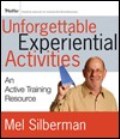UNFORGETTABLE EXPERIENTIAL ACTIVITIES: AN ACTIVE TRAINING RESOURCE
 From training expert Mel Silberman, Unforgettable Experiential Activities is a next-step resource based on his well-known Active Training programme. As accessible as it is useful, each one of the book's 75 original activities includes helpful training tips and techniques.
From training expert Mel Silberman, Unforgettable Experiential Activities is a next-step resource based on his well-known Active Training programme. As accessible as it is useful, each one of the book's 75 original activities includes helpful training tips and techniques.
The collection will help all trainers – both novice and experienced – engage their learners in active, experiential learning.
The activities are organized by today's most sought after training topics including:
- Change Management
- Communication
- Conflict
- Creativity
- Facilitation
- Influencing
- Leadership
- Negotiating
- Team Building
Table of Contents
- Preface
- Acknowledgments
- Introduction
- Chapter One: Getting Acquainted
- 1. Alphabetical Circle: A Fun Way to Learn Names and a Lot More
- 2. Group Résumé: Who We Are Collectively
- 3. Things We Have in Common: Getting to Know You
- 4. Predictions: Making Guesses About Co-Participants
- 5. Introductory Go-Arounds: Brief Self-Disclosures
- 6. What’s in a Name? My Story
- Chapter Two: Communication
- 7. Communication Tokens: An Awareness Exercise
- 8. Direct Communication: You Write the Scripts
- 9. Explaining Something Complicated: Avoiding Information Dumps
- 10. Obtaining Participation: Using Different Formats
- Chapter Three: Assertive Behavior
- 11. Concerns About Confronting Employees: Overcoming the Anxiety
- 12. Assertive Starters: Ways to Begin an Assertive Message
- 13. Non-Verbal Persuasion: Assessing Its Impact
- 14. Refusing Unwanted Requests: Practicing Saying No
- 15. Stating Complaints and Requesting Change: Skill Practice
- Chapter Four: Influencing Others
- 16. Alligator River: Looking at People with Different Glasses
- 17. Question First: The Best Way to Overcome Resistance
- 18. Influencing Others: Four Role-Play Scenarios
- 19. Getting Your Foot in the Door: Avoiding Rejection
- Chapter Five: Conflict and Negotiation
- 20. Views of Conflict: A Word Association Game
- 21. What You Bring to Conflict Situations: Experiencing Different Styles
- 22. The Ten-Thousand-Dollar Challenge: Working Through a Conflict
- 23. Role Reversal: Arguing the Flip Side
- 24. Rating Methods to Deal with Conflict: Yours and Theirs
- 25. Breaking a Stalemate: Steps to Move Forward
- Chapter Six: Creativity and Problem Solving
- 26. Getting Ready for Brainstorming: Creative Warm-Ups
- 27. Part Changing: Demonstrating a Technique to Increase Creativity
- 28. Brainwriting: An Alternative to Generating Ideas Verbally
- 29. Inspired Cut-Outs: Freeing the Mind
- 30. Wearing Someone Else's Shoes: Taking a Different Perspective
- 31. Making Decisions After Brainstorming: Narrowing the Options
- Chapter Seven: Diversity
- 32. Being in the Minority: Simulating an Everyday Reality
- 33. I've Been Curious: Questions I Have Been Afraid to Ask
- 34. Setting the Record Straight: Things About Me and Others Like Me
- 35. Unlocking Memories: Self-Disclosures in a Diverse Group
- Chapter Eight: Facilitating Teams
- 36. Multi-Voting: A Constructive Way to Make Decisions
- 37. Rotating Facilitators: Practicing Effective Facilitation
- 38. Card Exchange: A Unique Way to Stimulate Discussion
- 39. The Problem with Majority Voting: A Double Whammy
- 40. Changing the Rules: Altering Group Process
- 41. Removing Egos: A Tool for Team Facilitators
- Chapter Nine: Exchanging Feedback
- 42. Animal Metaphors: An Exercise in Obtaining Honest Feedback
- 43. Giving Effective Feedback: Wheaties Over Donuts
- 44. Judging the Impact of Words: Applications to Giving Feedback
- 45. When Asking for or Giving Feedback Is Challenging: Your Advice
- Chapter Ten: Leadership
- 46. The Window Shade of Decision Making
- 47. Mirroring: Experiencing the Joys and Tribulations of Being a Leader
- 48. Going Outside Comfort Zones: Brief Exercises in Change
- 49. Changes You Would to Make: Dreaming Beyond the Status Quo
- Chapter Eleven: Teaching and Coaching Employees
- 50. Making Butterflies: It's Not What You Say That Counts
- 51. Brain-Friendly Teaching: Using Four Key Principles
- 52. Building Skills Through Role Plays: You Have Options
- 53. The Components of Effective Coaching: Observing the Process
- 54. Show But Not Tell: Upping the Stakes
- Chapter Twelve: Understanding Others
- 55. Avoiding Labels: Interpreting Behavior Objectively
- 56. Be Curious, Not Furious: Five Ways to Understand Others
- 57. Comparing Yourself to Others: Looking for Differences and Similarities
- 58. The Three C's What Makes People Difficult
- Chapter Thirteen: Sales and Customer Service
- 59. A Convincing Sales Presentation: Warm-Up Practice
- 60. Dissatisfied Customers: How to Win Them Over
- 61. To Consult or Not Consult: Assessing Your Selling Style
- 62. Your Company's Sales Philosophy: How Do You Treat Customers?
- Chapter Fourteen: Building
- 63. The Stages of Team Development: A Card Sorting Activity
- 64. Television Commercial: An Unusual Team-Building Activity
- 65. Creative House Building: An Exercise in Teamwork
- 66. Fishbowl Meeting: Observing Group Process
- 67. Making Paper Cups: Simulating a Learning Organization
- 68. Are You a Team Player? Things Team Players Do
- 69. Paper Airplanes: The Power of Collaboration
- Chapter Fifteen: Train the Trainer
- 70. Active Vacations: Topics versus Objectives
- 71. Design Challenges: Planning How to Achieve Training Objectives
- 72. Energizers: Ways to Wake Up or Relax a Training Group
- 73. Has This Ever Happened to You? Making Team Learning Work
- 74. Training Styles: Three Continua
- 75. You Have Many Options: Increasing Your Training Repertoire